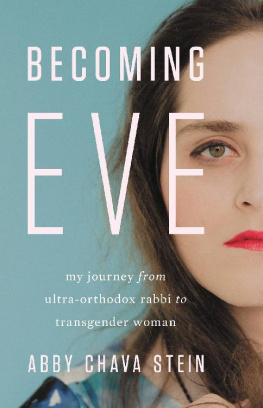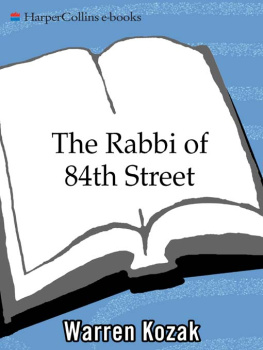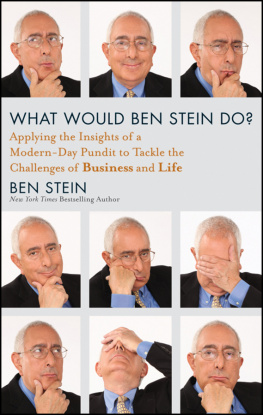Copyright 2019 by Abby Stein
Cover design by Ann Kirchner
Cover image Tawni Bannister
Cover copyright 2019 Hachette Book Group, Inc.
Hachette Book Group supports the right to free expression and the value of copyright. The purpose of copyright is to encourage writers and artists to produce the creative works that enrich our culture.
The scanning, uploading, and distribution of this book without permission is a theft of the authors intellectual property. If you would like permission to use material from the book (other than for review purposes), please contact permissions@hbgusa.com. Thank you for your support of the authors rights.
Seal Press
Hachette Book Group
1290 Avenue of the Americas, New York, NY 10104
sealpress.com @sealpress
First Edition: November 2019
Published by Seal Press, an imprint of Perseus Books, LLC, a subsidiary of Hachette Book Group, Inc. The Seal Press name and logo is a trademark of the Hachette Book Group.
The Hachette Speakers Bureau provides a wide range of authors for speaking events. To find out more, go to www.hachettespeakersbureau.com or call (866) 376-6591.
The publisher is not responsible for websites (or their content) that are not owned by the publisher.
Library of Congress Cataloging-in-Publication Data
Names: Stein, Abby, 1991 author.
Title: Becoming Eve: my journey from ultra-Orthodox rabbi to transgender woman / Abby Stein.
Description: First edition. | New York: Seal Press, [2019]
Identifiers: LCCN 2019016332 (print) | LCCN 2019019987 (ebook) | ISBN 9781580059176 (ebook) | ISBN 9781580059169 (hardcover) | ISBN 9781580059176 (ebk.)
Subjects: LCSH: Stein, Abby, 1991 | Jewish transgender peopleUnited StatesBiography. | Transgender womenUnited StatesBiography. | HasidimNew York (State)New YorkBiography.
Classification: LCC BM729.T65 (ebook) | LCC BM729.T65 S74 2019 (print) | DDC 296.8/332092 [B]dc23
LC record available at https://lccn.loc.gov/2019016332
ISBNs: 978-1-58005-916-9 (hardcover); 978-1-58005-917-6 (ebook)
E3-20190927-JV-NF-ORI
To my dear son, the love of my life,
Duvidl, to long years
Mighty waters cannot quench love; rivers cannot sweep it away.
(Song of Songs, 8:7)
Forever and Ever
Explore book giveaways, sneak peeks, deals, and more.
Tap here to learn more.

Let me fall if I must fall. The one I will become will catch me.
B AAL S HEM T OV
M Y COMING-OF-AGE STORY is based on two main sources: my own memories and the stories I have been told, mostly by my parents, grandparents, and siblings. As expected from any retelling that is based on memory, especially from the years when one is a child, small inaccuracies are inevitable. I did my best to write my memories authentically and truthfully, at times consulting notes from when I was young and fact-checking with relatives who still speak to me. I was not able to speak with my parents.
In many places, I have changed the names and identifying information of the people I have written about in my story to protect their privacy.
Almost all of the dialogue in this book was originally spoken in Yiddish. When translating from any language, it is difficult to avoid slight mistranslations, and this is especially true when translating from Hasidic Yiddish, a language and dialect that has no formal method of exact translation. I did my best to recapture the words and the intentions as they were originally expressed.
M Y GRANDFATHER WAS telling me a story.
Once, when I visited our uncle and I told him of my father-in-law, his family, and our lineage, Der Feter said in awe: Your children are among the most exalted in the world.
I tried not to look bored.
You see, Zeide explained, our family is directly descended from the Baal Shem Tov, the founder of Hasidism, and from the holiest leaders in all of Jewish history.
Whenever Zeide Stein, my paternal grandfather, spoke of Der Feter, I could hear the pride and respect in his voice. Feter is Yiddish for uncle, and his uncle was Rabbi Yaakov Yosef Twersky, the rebbe of the Skver Hasidic community, and one of the supreme leaders of Hasidic Judaism after the Holocaust. For a few years, when he was young, Zeide even lived in the Skvera Rebbes house so he could attend a nearby elementary school.
I had heard the vague outline of this story before and wondered where Zeide was going with all of this.
So what? I asked Zeide. So our ancestors were big leaders, and holy people. What does that have to do with us?
Well, Zeide said, stroking his beard, due to their holiness, their closeness to God and to the inner workings of the divine world, they secured higher souls for their children, grandchildren, and descendants for generations to come.
Zeide, you make it seem as though we are like a medieval European regal family, when people believed that God chose the king. Its not like were royalty, I said.
No, no, that is exactly what we are! Zeide interrupted. That is exactly what I am telling you! Being direct descendants of the Holy Baal Shem Tov means that we are like princes!
I rolled my eyes and gave Zeide a look that said Yeah, right. He smiled.
Our sages have said that if the Baal Shem Tov had lived in biblical times, he would have been a patriarch. He would have been a Moses, and we would have counted him among Abraham, Isaac, and Jacob! Imagine his power! And now imagine how holy the souls of his descendants are.
What the story about Der Feter meant was that this illustrious lineage came down to us from multiple sources. It was not just Zeides mother, and his uncle, who descended from the Baal Shem Tov. Zeides father-in-lawthe father of Bobbe Stein, my grandmotherhad a significant lineage in Judaism as well. The complexities of my ancestry were as confounding as they were supposedly impressive.
I didnt believe most of what Zeide said about our regal stature, but by then I was fifteen years old and questioning everything I was told about religion. Besides, learning that I was somehow holier than others, which in turn meant I had to act holier, was not something I was interested in doing.
But I also knew that among the one million or so Hasidic people in the Ultra-Orthodox Hasidic Jewish world, it was considered a reality.
GEOGRAPHICALLY, I WAS born and raised in New York City. Culturally, I was raised in an eighteenth-century Eastern European enclave in the heart of its capital, the Ultra-Orthodox Hasidic Jewish community in Williamsburg, Brooklyn.
I grew up in New York, but I did not speak English, visit museums or the theater, or wear jeans. Popular culture, from television to newspapers to the Internet, was shunned; Britney Spears and the Beatles were not only forbidden but didnt even exist for me. I hadnt heard of Friends or Seinfeld, or many major historical events, from Woodstock to the Stonewall Riotsthey were spurned topics, and we were kept from ever learning about them.
After Nazi Germany invaded Poland, the Hasidic community was all but decimated, and a few thousand families came as refugees to the United States. In New York, several Hasidic rebbes settled in Brooklyn with a hard task in front of them: rebuilding the Hasidic community from scratch. Undaunted, they set out to re-create Eastern European Hasidic shtetel life.









